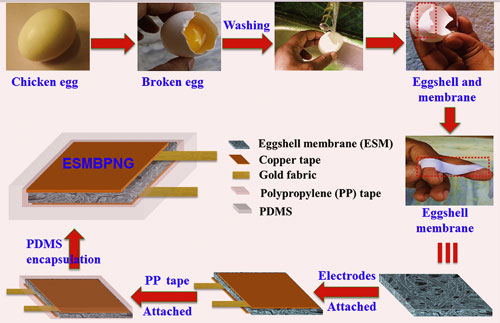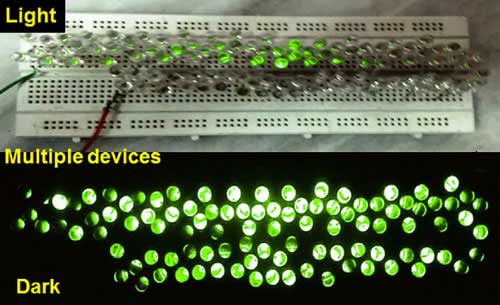| Posted: Jun 12, 2018 | |
Eggshell membranes from bio waste could be harvesters for green energy |
|
| (Nanowerk Spotlight) Bio-inspired materials have been considered as brilliant energy harvesting materials for their non-toxic and biocompatibility nature. Bio-based piezoelectric materials would be a promising clean and sustainable green energy source with the ability to generate and supply huge amounts of pollution-free power. | |
| So far, there have been few reports on biocompatible and biodegradable biowaste-based piezoelectric materials, due to their low piezoelectric coefficient, low power and low energy conversion efficiency. | |
| This has hindered the fabrication of bio-piezoelectric nanogenerators (BPNGs) with high power density and high energy conversion efficiency. Furthermore, reported bio-piezoelectric devices have serious drawbacks, including availability, toxicity, a lack of biodegradability and bio-compatibility as well as complex fabrication steps, which limit their potential applications in real life/biomedicine and suitability for industrial production processes. | |
| In this new work (Materials Today Energy, "A new insight towards eggshell membrane as high energy conversion efficient bio-piezoelectric energy harvester"), Prof. Bhanu Bhusan Khatua and his team from Indian Institute of Technology (IIT) Kharagpur, India, have explored inexpensive, biodegradable and daily-waste eggshell membrane (ESM) as a novel bio-piezoelectric material for harvesting green energy for future generation. | |
 |
|
| Schematic of fabrication of self-powered bio-nanogenerator from eggshell membranes. (© Elsevier) (click on image to enlarge) | |
| The uniqueness of our work lies in the novelty of directly utilizing natural eggshell membranes as efficient piezoelectric material. This simple, innovative approach definitely could provide huge benefits for research in future energy science, especially with regard to in vivo biomedical applications. | |
| Our eggshell membrane-based self-powered bio-nanogenerator (ESMBPNG) shows excellent energy conversion efficiency of ∼63% and outstanding instantaneous power density value of ∼238.17 µW/cm3 respectively, through simple biomechanical activities, which are higher than other chemically untreated bio-piezoelectric materials (details description of comparative studies are illustrated in the Supplemental Information of the paper) reported to date. | |
| The fabricated ESMBPNG generated output voltage of ∼26.4 V and current of ∼1.45 µA. Thus, bio-waste eggshell membrane would be an eye catching material for green energy harvesting application in near future. | |
| Compared to other biocompatible and/or biodegradable piezoelectric materials, our device achieved high piezoelectric sensitivity in the order of ∼23.7 pC/N. | |
| In addition, an assembly of five ESMBPNGs provides an outstanding output voltage (∼131 V) and current (∼6 µA) in series and parallel connection, respectively. We demonstrated that multiple devices can power up more than 90 green LEDs. | |
 |
|
| Multiple devices can power up more than 90 green LEDs in light (top) or dark (bottom). (© Elsevier) | |
| This indicates that one can easily increase further output voltage by assembling more ESMBPNG devices in series for large-scale applications. The output performance of the ESMBPNG is far better than previously reported bio-based piezoelectric materials: for instance, an output voltage of ∼0.4 V and current of ∼4 nA for virus-based piezoelectric material, and ∼10 V and ∼51 nA for fish swim bladder. | |
| We demonstrated some practical applications, for instance by placing the bio-nanogenerator onto the insole of a shoe. This has the ability to generate power by pressure from normal walking and turn on green LEDs instantaneously. | |
| Moreover, we can design our devices in series (either layer-by-layer or side-by-side arrangements of multiple devices) under a treadmill, dance floor, or shoe rubber; it can easily harvest green energy for turning on LEDs or mobile charging during walking or running. | |
| The instantaneous power density of our ESMBPNG is the highest so far reported in the literature. Furthermore, ESMBPNG is ultrasensitive towards very minute pressure arising from pulse; various body motions at rest (swallowing, coughing, gargle, drinking etc.) and walking (feet pressing, running etc.), falling water drops, even writing on the device. As it works at very low pressure originating from arterial pulse or beat, it could be used in blood pressure monitoring and health care units. | |
| Finally, ESMBPNG successfully differentiates speech/voice signals, indicating its potential for speech recognition. | |
| Our findings could be a step towards energy harvesting technology of bio-nanogenerators as self-powered implantable and wearable electronics. | |
| We believe that our innovative finding will excite interdisciplinary researchers who are interested in biodegradable and biocompatible piezoelectric materials and next-generation power sources for smart electronics and health/biomedical application. | |
| Our innovation is a result of extensive research work carried out in Prof. Khatua's laboratory at the Materials Science Centre, IIT Kharagpur, India, with his PhD student Mr. Sumanta Kumar Karan and others. The results were also tested and verified with a collaborative research team of Prof. Jin Kon Kim from POSTECH, South Korea. | |
| Prof. Khatua, Mr. Sumanta Kumar Karan and Dr. Sandip Maiti are highly optimistic about IP generation and commercializing the technology soon. | |
|
Provided by Indian Institute of Technology Kharagpur as a Nanowerk exclusive
|
|
|
Become a Spotlight guest author! Join our large and growing group of guest contributors. Have you just published a scientific paper or have other exciting developments to share with the nanotechnology community? Here is how to publish on nanowerk.com. |
|
